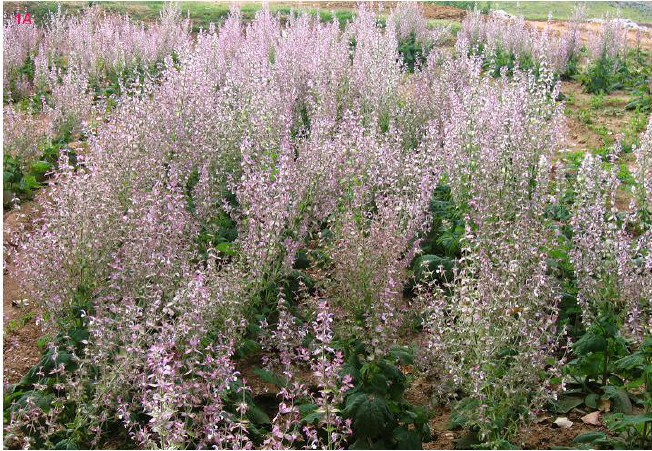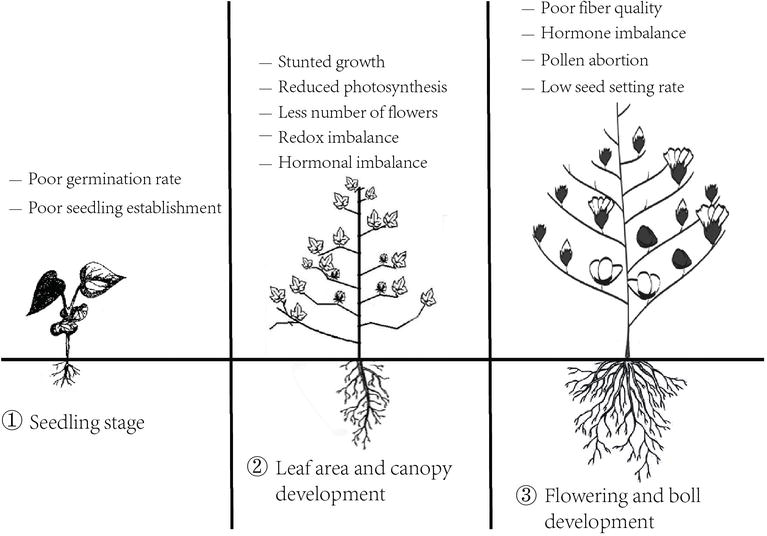October 21, 2020 at 9:39 pm | Updated March 16, 2022 at 11:32 am | 6 min read
Temperature is one of the essential factors that influence plant physiological processes. Its influence can be felt from germination to the production of fruits in plants. Thus, the rising temperatures associated with climate change could have a profound impact on crops and their productivity. These are some questions that are being explored by scientists through the use of portable precise tools in the field.
Temperature’s Importance for Plants
Temperature controls plant physiological processes like photosynthesis, respiration, transpiration, water and nutrient transport, and biochemical pathways. Temperature can activate and affect all stages of a plant from germination, growth, to reproduction. The ideal range lies between 00C to 400C; although, this range will depend on the species and varieties of the plant and can vary in different stages.
Temperature determines where and when plants grow. Therefore, they influence plants’ geographical distribution and season of occurrence.
Subscribe to the CID Bio-Science Weekly article series.
By submitting this form, you are consenting to receive marketing emails from: . You can revoke your consent to receive emails at any time by using the SafeUnsubscribe® link, found at the bottom of every email. Emails are serviced by Constant Contact
Night and day temperatures will be affected as a result of climate change. It is expected that temperatures could increase more at night than during the day.
Some plant processes are time-specific and occur either during the day in the presence of light or later at night. Hence, the chemical composition of plants will be different depending on the time of day. Also, there is a high and low night temperature, as the earth cools in the absence of solar radiation.
For example, photosynthesis fixes carbon during the day to produce leaf adenosine triphosphate (ATP) and simple sugars. The sugars are then converted to starch. In the night, the starch is converted into sucrose, sent to the phloem, and transported to other parts of the plant. The products and by-products of just this one cycle will be used in different biochemical reactions.
So, the time when temperature varies can have a profound impact on several plant physiological processes
Higher Temperature Can Improve Growth But Not Essential Oil Composition
Aromatic plants owe their health benefits and, therefore, economic value to biochemicals produced by plants.
The effect of elevated temperature was tested in the aromatic plant, Salvia sclarea, along with that of a higher concentration of carbon dioxide (CO2). Scientists wanted to see how the growth, essential oil content, and composition would be affected. The experiment was conducted in the Himalayas in India.

Figure 1: A field of Salvia sclarea, Nadda et al. 2012. (Image credits: Mun. Ent. Zool. Vol. 7, No. 1, January 2012)
The temperatures were increased by 2.5–3.00C above ambient and CO2 to 550 ± 30 μmol mol−1. Growth parameters measured were the number of leaves per plant, plant height, and leaf area per plant. Yield parameters of biomass accumulation and essential oil composition were also studied.
To measure the leaf area, scientists used the CI-203 Handheld Laser Leaf Area Meter, manufactured by CID Bio-Science Inc. It is a small handheld device that uses a laser scanner to measure the leaves’ length, width, area, perimeter, shape factor, aspect ratio, and void count. There is a built-in GPS that can quickly identify plants and leaves for future measurements. Data is collected in a card that can be transferred to a computer. The whole process of measuring a leaf is over within seconds.
The measurements are non-destructive, so the leaves do not have to be plucked and can be measured several times during the plants’ growth and could be included in the calculation of biomass. This made the Salvia experiment more precise.
After a year, higher temperatures improve plant growth. There were 58.0% more leaves per plant, and the leaves were 64.9% larger. Biomass production was also 162.4% more. Some components of essential oil increased, such as linalyl acetate, but violaxanthin and neoxanthin were reduced due to higher temperatures.
Higher levels of CO2 reduced the number of plant leaves and area, and the increase in biomass was only slight. Glutathione content also increases due to more CO2.
Hence, though plant growth and yield increase, the essential oil composition changed due to both higher temperatures and CO2.
Physiology Affected by High Night Temperatures Inhibits Flower Production
Since night temperatures are going to be affected more than day temperatures, a study focused on the effects of night temperatures on the reproductive stage of cotton.
Figure 2 shows how high temperatures can stress cotton and affect it at various stages of its life-cycle. Of all the processes, the reproductive steps are most sensitive to temperature stress, when it is over 320C. Unfortunately, temperatures higher than the optimum are typical in the tropics where cotton (Gossypium hirsutum L.) is grown, so the yield is often low.

Figure 2: “Effect of high temperature on agronomic and physiological attributes of cotton at various developmental stages,” Hasanuzzaman et al. 2017. (Image credits: https://doi.org/10.1007/s12298-017-0422-2)
Scientists studied changes in response to heat during the reproduction stage in different physiological processes—like photosynthesis, membrane damage, and respiration—and the consequent effect these changes had on cotton. The experiment traced levels of ATP, glutathione reductase (GR) content, as well as soluble carbohydrate concentrations in leaves near flower buds.
The plants were raised in growth chambers, so day temperatures were maintained at average (24-320C) and night temperatures were increased to 30-320C for seven days.
Photosynthesis was measured by the CI-340 Handheld Photosynthesis System, also produced by CID Biosciences Inc.
This device is attached to a leaf chamber that comes in ten different sizes to accommodate various species. It measures the gas exchange that occurs in the leaves, so besides photosynthesis, it can measure many physiological processes like respiration, transpiration, and stomatal conductance. It can also measure PAR, chlorophyll fluorescence, and internal CO2. It is possible to adjust the temperature, light intensity, CO2, and water (H2O) with the help of modules. The tool is designed to make non-destructive analysis in the field.
In the case of cotton, after seven days, a rise in night temperature immediately increased respiration and membrane damage. Photosynthesis and ATP production were lowered, as were GR levels. GR is a chemical that is usually produced by plants as a protective measure in response to stress. The negative effect of high night temperatures also reduced the concentrations of sugar and starch in leaves. However, the flower buds still had higher carbohydrate content. There was an overall reduction in the number and weight of flower buds that were produced because their GR was less.
In another study of cotton growth, scientists used the F-750 Produce Quality Meter from Felix Instruments to non-destructively measure the maturity of unopened cotton bolls. In this instance, the tool measured boll maturity with a 96% average accuracy rate without having to use the manual boll cutting technique that has been used in the past.
Mixed Results
The effect of higher temperatures can elect mixed responses from plants. Even though vegetative parameters and biomass increases, the biochemical processes are usually negatively affected. As a result, this often adversely affects the quality and quantity of yield. Plants have to cope with the stress caused by raised temperatures. As the cotton study shows, even their defense against stress can be compromised by heat, so the more heat-resistant varieties will have to be selected for future agriculture.
—
—
Vijayalaxmi Kinhal
Science Writer, CID Bio-Science
Ph.D. Ecology and Environmental Science, B.Sc Agriculture
Feature image courtesy of Kimberly Vardeman
Sources
Dyer, M.H. (2018, April 4). Does Weather Affect Plant Growth: Effect Of Temperature On Plants. Retrieved from https://www.gardeningknowhow.com/plant-problems/environmental/temperature-on-plants.htm
Hasanuzzaman, M., Nahar, K., Anee, T. I., & Fujita, M. (2017). Glutathione in plants: biosynthesis and physiological role in environmental stress tolerance. Physiology and molecular biology of plants : an international journal of functional plant biology, 23(2), 249–268. https://doi.org/10.1007/s12298-017-0422-2
Helmenstine, A. M. (2019, May 26). Learn About the Calvin Cycle in Photosynthesis and Carbon Fixation. Retrieved from https://www.thoughtco.com/what-is-the-calvin-cycle-608205
Jing, P., Wang, D., Zhu, C., & Chen, J. (2016). Plant Physiological, Morphological and Yield-Related Responses to Night Temperature Changes across Different Species and Plant Functional Types. Frontiers in Plant Science, 7. doi: 10.3389/fpls.2016.01774
Kumar, R., Kaundal, M., Sharma, S., Thakur, M., Kumar, N., Kaur, T., … Kumar, S. (2017). Effect of elevated [CO 2 ] and temperature on growth, physiology and essential oil composition of Salvia sclarea L. in the western Himalayas. Journal of Applied Research on Medicinal and Aromatic Plants, 6, 22–30. doi: 10.1016/j.jarmap.2017.01.001
Loka, D. A., & Oosterhuis, D. M. (2016). Increased Night Temperatures During Cottons Early Reproductive Stage Affect Leaf Physiology and Flower Bud Carbohydrate Content Decreasing Flower Bud Retention. Journal of Agronomy and Crop Science, 202(6), 518–529. doi: 10.1111/jac.12170
Long, R., Bange, M. (2020, April 2). Measuring the Maturity of Unopened Cotton Bolls with Near Infrared Spectroscopy. Retrieved from https://journals.sagepub.com/doi/abs/10.1177/0967033520911463
Went, F.W. (1953). The Effect of Temperature on Plant Growth. Annual Review of Plant Physiology 1953 4:1, 347-362
Zafar, S. A., Noor, M. A., Waqas, M. A., Wang, X., Shaheen, T., Raza, M., & Mehboob-Ur-Rahman. (2018). Temperature Extremes in Cotton Production and Mitigation Strategies. Past, Present and Future Trends in Cotton Breeding. doi: 10.5772/intechopen.74648
Related Products
Most Popular Articles
- Transpiration in Plants: Its Importance and Applications
- Leaf Area – How & Why Measuring Leaf Area…
- How to Analyze Photosynthesis in Plants: Methods and Tools
- Plant Respiration: Its Importance and Applications
- The Forest Canopy: Structure, Roles & Measurement
- Stomatal Conductance: Functions, Measurement, and…
- Forest & Plant Canopy Analysis – Tools…
- Root Respiration: Importance and Applications
- The Importance of Leaf Area Index (LAI) in…
- Irrigating with Saline or Seawater






